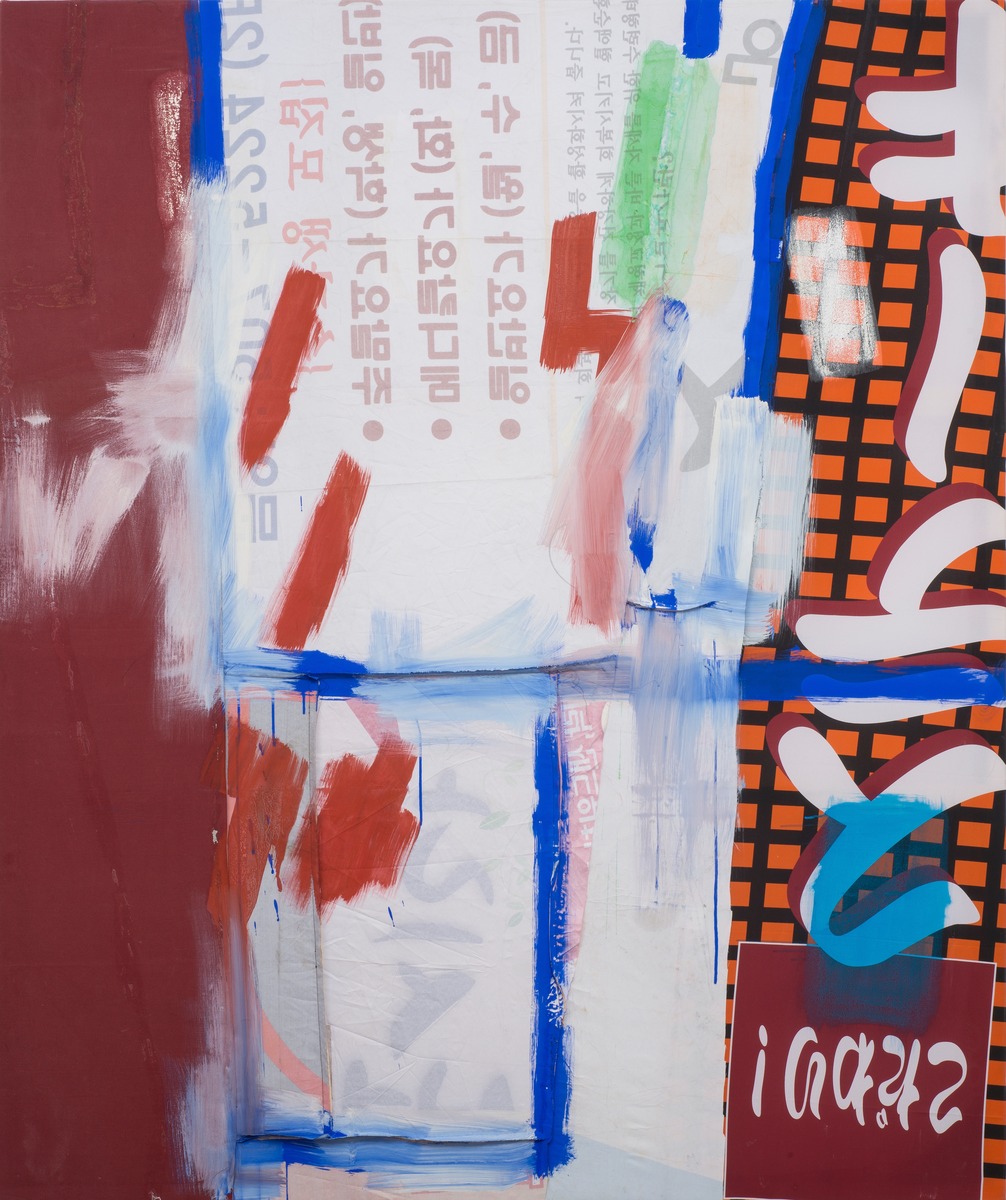JOE FYFE
January 14 - March 12, 2016
JOE FYFE
January 14 - March 12, 2016 Vagabond paintings
The painter Joe Fyfe has said that he has long been preoccupied by the lines in Sartre’s La Nausée where the main character observes the fictional Boulevard Noir: … « No one has bothered to adorn it. (...) It is inhuman. Like a mineral. (...). Straight, dirty corridors, full of drafts, with wide, treeless sidewalk. They are almost always outside the town in these strange sections where cities are manufactured near freight stations, car-barns, abattoirs, gas tanks ». The margins, as Fyfe describes them, exist contemporarily where consumerist culture is enveloping more traditional, rural societies. Vagabondage describes his process of finding materials while traveling and on the streets surrounding his studio, as well as characterizes the materials themselves, which seem to wander from one place to another as they change their identifiable function. For example, some works were assembled from recycled Korean outdoor advertisements that were found in Cambodia, where the material is reused as boat covers and sun-blocking tarps. Later, they became Fyfe’s paintings.
“The operation I am involved in is the opposite of an elevation found materials” he said “I seem to be the last stop before these things return to the earth”.
Press release ( Selection )
As the artist & critic David Rhodes has written on the work of Joe Fyfe, “Improvisation, re-use, and reconfiguration are all at play.” This most recent exhibition continues the use of fabrics found in the markets of Southeast Asia as well as rural Walmarts in the U.S., fragments of Hebrew signs found near his neighborhood in Brooklyn and European souvenir shops. In addition other found objects put to use include broken umbrellas, kites, felt and flags. “Fyfe's pieces are both formal and throwaway” wrote Howard Halle in TimeOut New York, “Hints of Rauschenberg and Tuttle can be seen in Fyfe's work, but it's uniquely and magnetically his own”.
“In Joe Fyfe's work, the inherent characteristics of any given material are presented foremost and combined with a sense of highly nuanced formal invention. Materials and objects are sewn, glued, tied, or left leaning together; there is no idealization or "neutral ground" sought for painting — and painting and its possibilities is the subject of this exhibition — as medium specific. Displacement is regarded as a normal state — wood, fabric, and paint gestures are rehoned as fragments of a precise composition….everything can be seen as having already existed somewhere else out in the world — be it a banner or a gestural mark, it can also be seen as interchangeable and capable of surprising and unexpected reconfiguration. …A national flag can be a pictorial support, a coat of paint on a fence, a pictorial invention. The idea of the found object, as Duchamp would have it, is turned on its head, as it becomes one more resource for painting…it is clear that in the particular selection of materials…indicates an interest in the way quotidian forms of urban or rural improvisation — the building of dwellings or fences, decorative and practical use of material — reflect socio-economic realities of local people. Fyfe resourcefully makes use of obdurate materials, whether patching a wall or using collage in a painting. However, in considering the piece formally and conceptually there is as much humor or gravitas as the viewer decides, given the fractured quality of the constituent parts and the Beckett-like deftness of their piecing together.
Overlooked in comparison to developments in painting this side of the Atlantic, artists such as André-Pierre Arnal and Claude Viallat — both included in Canada's 2014 Supports/Surfaces exhibition, for which Fyfe provided one of the catalog texts — are beginning to finally get their due.” – David Rhodes, The Brooklyn Rail
“Rooted in the likes of Beuys, Arte Povera, Rauschenberg, and Richard Tuttle, these works, made from a rich and motley trove of materials — felt, cotton, flags, bricks, tires, a black car bumper, drums, a capsized umbrella, signs, and more, were set on the floor, hung on walls, and suspended from on high….Though seemingly effortless, based on serendipitous, sensitively inspired pairings, the works were held together by a formal intelligence that belied that nonchalance. His is a populist art for the cognoscenti, a wry transfiguration of the insistently commonplace, one that is not without political rumblings. Fyfe's creations also take the temperature of the region's transitions, its growing materialization and globalization, with a nod — the Union Jack that emblazons the surface of Bull (2014), say — toward its complicated past. The oddly appealing, cobbled-together Bench (2012–14) of uncertain durability is poignantly symbolic ”. — Lilly Weh, ARTNEWS




